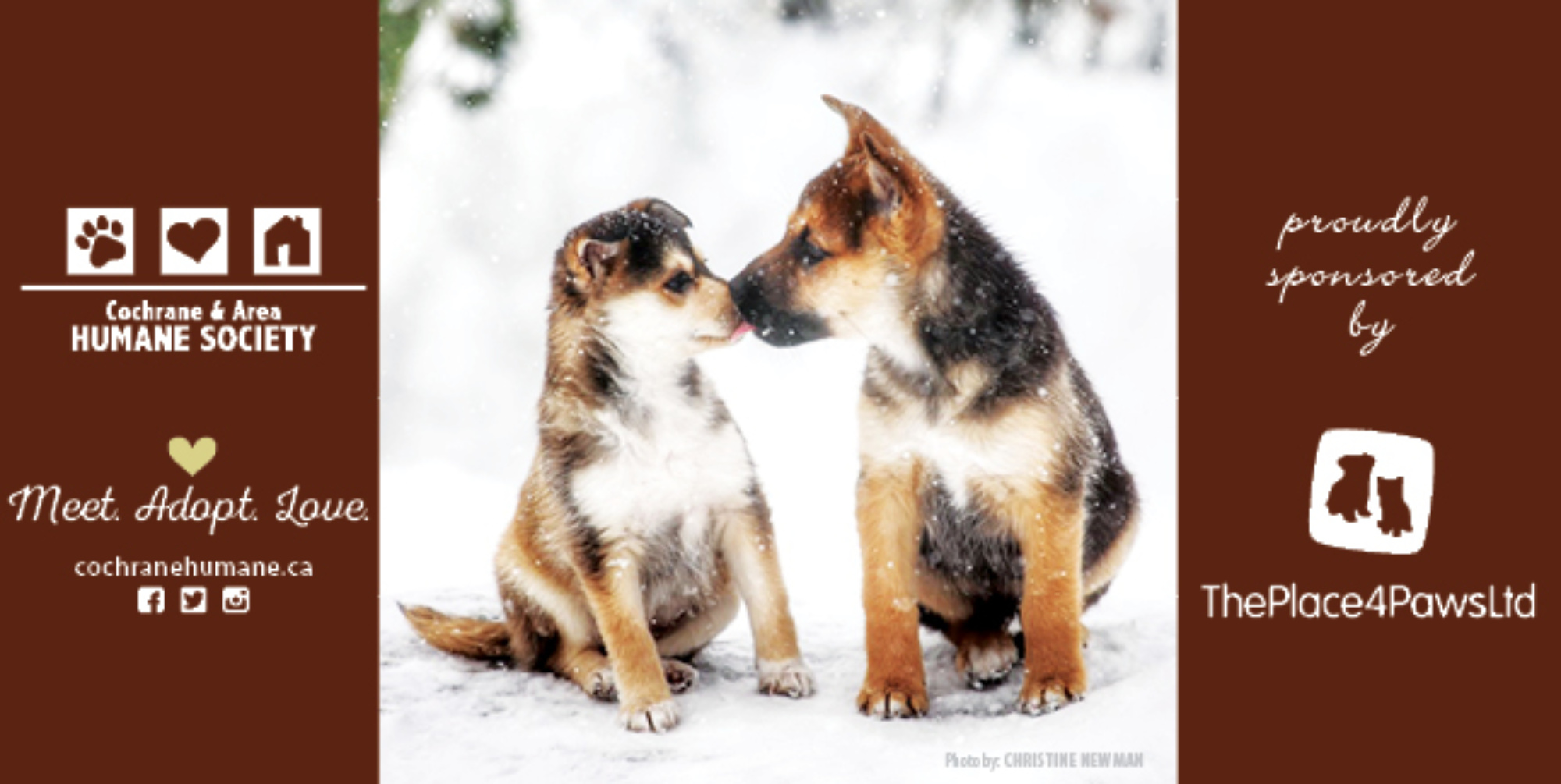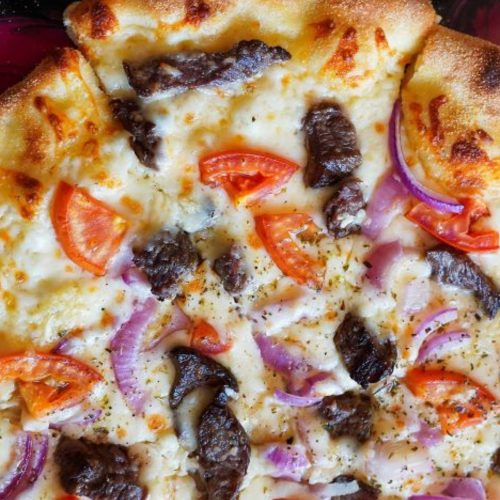Welcome to our new weekly blog that is brought to you by the Cochrane & Area Humane Society and proudly sponsored by The Place 4 Paws Ltd. Keep an eye out on our social media for the weekly Pet Of The Week that is up for adoption!
Week 46 – Loud Noises

Is your dog afraid of loud noises? Most dogs don’t mind them, but there are those who have developed fear towards loud noises. This fear is stressful for your dog and can limit activities your dog can participate in with you. Since dogs don’t understand noises won’t hurt them, we need to find other ways to alleviate their fear.
Thunder, fireworks, and loud vehicles are probably the most common noise triggers. Here are some ways to help your dog feel safe when things go boom:
- Provide a safe space for your dog or enhance one that he/she has chosen. Put a crate or bed in it. Give a very special long-lasting treat or a hollow rubber chew toy that can be stuffed with something good.
- Leave the crate door open. If your dog’s fear is so severe that he/she panics and tries to escape a crate, leave the door open. Dogs can be injured or lost in their efforts to get away from frightening noises.
- Before your dog has a chance to get upset about a noise, distract him/her with a fun game like fetch or tug. Practice some tricks and/or obedience skills and give nice rewards for focusing on you. If your dog reaches a point where he/she can’t focus, it’s best to stop. Don’t create an unpleasant association with games and behaviours that he/she normally likes.
- Reward calm behaviour. Don’t wait for your dog to show signs of stress before you give attention. Play calming music or turn on the television may help to muffle the loud noises.
- Condition your dog to loud noises early. Take it slowly because it may take months to alleviate already established fears. A good way to start, is by dropping a small book (from a distance) while you reward and play. If he/she startles, stay calm and cheerful and give treats, like cooked chicken breast or beef liver. Soon, your dog will learn that it’s nothing to worry about.
Any calming device, whether it be soft music, or a snug dog shirt, should be occasionally used when the weather is good and your dog is happy. This will help him/her develop positive associations with them—not just scary ones.
The Cochrane & Area Humane Society offers a variety of behaviour and training services that can help you cope with your fearful or anxious dog. Please visit our website for more details: www.cochranehumane.ca/programs/animal-training
Week 45 – How to help a stressed Cat
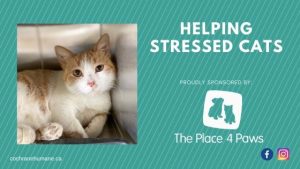
When our cats are faced with something stressful, they usually like to hide. Providing safe spaces in your home gives them somewhere to hide and relax if they are feeling stressed. From a cat’s perspective, the best hiding places are usually the right size for them and enclosed. Cats also like to be high up and have nice places to perch where they can see what’s going on. In a multi-cat home, cats that are friends may choose to cuddle up in the same safe spaces, but cats should always have access to their own independent safe spaces too. There are many ways to provide your cat with safe hiding spaces. Here are some tips to help your cat stay calm and happy in their own spaces.
Cat trees
Cat trees have several levels and allow the cats to climb up higher. Many of them also include a space that is either enclosed by a low rim that enables the cat to have a little bit of cover or have a completely enclosed area for the cat to hide in. Most cat trees also contain scratching posts, which is great so they will refrain from scratching your furniture or carpets.
Cat beds, caves, hammocks and tunnels
Cat beds and caves make nice places for cats to curl up and relax. Place them in quiet places where you spend a lot of time so they can be near you but still feel safe in their own space. A cat hammock could be placed near a sunny window or in a warm part of the room. Cats can use cat tunnels as a hiding place too, but they are also fun for playtime.
Cat Carrier
Ideally, the cat carrier should be a nice safe place for your cat to hang out… rather than a terrifying contraption that only comes out when it’s time for a trip to the vet. It’s a good idea to keep the carrier out at all times, in a place where your cat can use it. Line the carrier with something cozy and place treats in there so it becomes a good experience for your cat. If your cat is used to relaxing in the carrier, it can really help when you go to the vet, because the carrier becomes a safe space for them in the vet’s office.
You don’t have to spend money to make nice hiding places for cats. Take a look round your house and identify the spaces your cat already uses, and other spaces that you could make for them to use. For example, maybe your cat already likes to cuddle up in the linen closet or under a pile of clothes in the laundry basket? If possible, you should protect those as safe spaces for your cat.
If you are looking for a feline companion, please visit our website to see our available adoptable cats.
http://www.cochranehumane.ca/adopt/cats/
Week 44 – Your pet and the holidays

The holidays are a wonderful time of year – but they can also present some danger to your pets. Here are some tips for keeping your pets holly jolly over the holiday season and out of danger.
Foods to avoid giving your pet during the holidays (and always):
· Chocolate can cause seizures and death in dogs and cats. Darker chocolate, such as unsweetened bakers chocolate is more toxic than milk or white. The toxic ingredients in chocolate include caffeine and a chemical called theobromine. Don’t feed or allow your pets to get their paws on any holiday chocolate treats.
· Ingesting onions or garlic can damage healthy red blood cells, leading to life-threatening anemia if not caught and treated in time.
· Xylitol has become more popular in recent years and is now included in a lot of “sugar free” labelled items. Xylitol can cause low blood sugar and liver failure in dogs.
· If you have any coffee, tea or other caffeinated beverages, don’t leave it anywhere your pet could take a sip. The caffeine can prompt seizures, abnormal heart rhythm and death in pets.
· Cooked chicken or turkey bones become very brittle when cooked. They can splinter easily and break into shards. They can become stuck in your pets mouth, throat or intestinal tract. Never feed these to your pet.
Pet hazards with holiday decor:
· Holly, mistletoe and lilies are poisonous to pets if ingested and should be kept out of reach of your pets.
· Keep Christmas gift wrap and decorations off the floor so your pet doesn’t get any ideas of chewing or eating them.
· Pets aren’t fans of loud noises, so be aware of things like popping champagne bottles, Christmas crackers, balloons or nearby holiday fireworks.
· If you have a real Christmas tree, fallen needles are very sharp and can easily get stuck in your pet’s paws or throat. Sweep tree needles up regularly or keep your pet and tree separate.
· Cover up electric cords so your pet can’t chew them.
· Cats, especially, will show a great interest in decorations hanging from your tree. Try to use unbreakable decorations and nothing too small that they will be able to swallow.
· Avoid tinsel or ribbons as these are dangerous to the gastrointestinal tract if your pet swallows them
Most pet related Christmas dangers are easy to avoid so just have fun and remember to be pet safe! Provide lots of enrichment opportunities for your pets so they can stay out of trouble this holiday season. Norm’s Nook Pet Supply Store at the Cochrane & Area Humane Society offers a variety of enrichment items for your pet. Visit www.cochranehumane.ca/programs/dog-and-cat-food-sales/ for more information or drop by the shelter during public hours.
Week 43 – Get to know your dog’s calming signals

Trainer Turid Rugaas of Norway spent years observing wolves, wild dogs and domestic canines to better understand how they communicate. Calming signals are a means of communication used by dogs to not only calm themselves, but also each other and even us. Knowing calming signals allows us to better understand how our dogs are communicating. Once we know and understand the calming signals, we will know when to remove our dogs from situations they are uncomfortable with because we’ll see the warning signs ahead of time.
Blinking – This is done to avoid staring/direct eye contact. It can be full, slow blinking or just the lowering of eye lids.
Curving – It’s proper ‘doggy manners’ for dogs to approach each other by curving to greet. They do not greet each other by approaching straight on unless they know the other dog. Approaching another dog straight on may cause conflict between the dogs. If your dog tries to curve when meeting another dog, let them do it – they are providing a clear message and proper dog communication. You can help your dog on walks by allowing them to curve away while on leash so that they do not send the wrong message or indicate a challenge to the other dog.
Licking – You may see your dog licking his mouth/nose when he is in a tight situation such as when another dog or person is walking straight towards him or when you are bending over your dog. This is most common in dogs with dark faces as it is harder to see their facial expressions.
Looking Away – This can be from the whole head or by just casting the eyes away. It is considered the most common calming signal that dogs will use. They will look away from anything that needs calming as staring directly at another dog can be considered threatening or a challenge.
Play Bow – A play position is when a dog has his front legs down and his bum in the air. It is used to initiate play as well as a calming signal. If a dog is uncertain with how to deal with a situation, he will often exhibit the play position. This is seen most commonly when a dog encounters a strange animal such as a cow.
Sitting/Lying Down – Dogs may do this to reassure one another that they mean no harm.
Sniffing – Dogs will commonly sniff the ground to calm a situation or another dog down.
Turning Away – A dog who is feeling a bit nervous about an object, person or another animal will turn away from it. This can be rather slight with just turning the head, or they may completely turn away. You will often see dogs do this to each other if one is playing inappropriately.
Walking Slowly – Dogs will move slower to calm another dog or person down, or will do this if another dog is feeling uncertain about a situation. This is a common one to see in dog play and greetings.
Yawning – Your dog may yawn when he’s tired but it is also used to release stress and calm others. When the dog is using a calming signal when yawning, the yawn tends to be exaggerated.
If you would like to further understand your dogs’ behaviour or work on training, Cochrane & Area Humane Society offers a variety of seminars, training and behaviour consultations for you and your dog. Please visit http://www.cochranehumane.ca/programs/animal-training/ for more information.
Week 42 – Do you talk to your pet?

Do you talk to your dog? Not just in a baby voice but do you have full-on conversations with your dog like they are a person? Maybe about the weather or about the latest gossip in entertainment or politics? Apparently talking to your dog — or cat, or plants, or pretty much anything that isn’t a person — is called anthromorphizing, which is the attribution of human motivation, characteristics, or behavior to animals, natural phenomena or inanimate objects.
This is good to know because we see people talking to their pets constantly. Asking them questions about their day, if they missed us, about their favorite toys and whether or not they would like a treat. Based on the looks your pet gives you, these conversations are probably confusing for the most part (though they understand way more that we realize). Expecting our pets to think like humans is common among pet owners. One of the reasons that dogs earned the title “Man’s Best Friend” was most likely due to their ability of adapting to our lives. This skillset has been win-win for both of us though.
In terms of behaviour, when a dog is in any other state than being calm ie.) if he’s aggressive, obsessive, scared, hyper or anxious and we give him a hug or pat on the head and tell him it’s okay, it is comforting to us, but it only reinforces the state of mind for the dog, making the experience more intense. While we think we’re soothing the dog, the dog thinks we approve of the inappropriate behaviour.
We can improve our relationships with our pets and ultimately their behavior if owners make a valid effort to understand their pets’ unique emotional makeup and learn what their body language is saying. Making your dog or cat a birthday cake or filling a holiday stocking with treats is certainly not a crime, it’s an act of love and appreciation of our pets, but people should be wary when their own actions unintentionally reward unwanted behaviours because we find something they do is cute or funny.
It is encouraging, though, to know that talking to our pets and our desire to engage with them isn’t out of the ordinary it is completely normal behaviour for us to think of our pets as one of us.
If you would like to further understand your dog, the Cochrane & Area Humane Society offers behaviour consultations for you and your dog. Please visit http://www.cochranehumane.ca/programs/animal-training/ for more information.
Week 41 – Indoor Exercise for your Pets in the Cold Months

Winter is just around the corner and just like us, our pets can pack on a few extra pounds over the season.
Over the winter when the temperature drops, here are some tips to help keep your pets active, even indoors!
- While getting outside for fresh air is still important, being mindful of how deep in the minuses it is and the wind-chill is a must. If your dog is shivering or lifting paws, it’s too cold. Dog sweaters & coats and booties are an option on cooler days.
- Visit local pet supply stores for long walks through the aisles and some socialization.
- Play fetch with an indoor safe toy and add a little extra to the work out by throwing the ball up 2-3 steps if you have them
- If you take some time to safely train your pet to use the treadmill using positive reinforcement methods, it can be an exercise tool for your dog, or cat too! (Never use a leash while your pet is on a treadmill)
- Registering for an indoor agility class is a fun way to release some energy. http://www.cochranehumane.ca/programs/animal-training/
- Make meal time more fun with some stimulating, interactive puzzle toys that contains their food. This keeps them busy and adds a little challenge. Norm’s Nook has various Snuffle mats and puzzle toys for your pet! http://www.cochranehumane.ca/programs/dog-and-cat-food-sales/
- Have an indoor play date with one of your friends and their dogs.
- Rotate your pet toys so they stay interested. When rotating toys for cats, place them in a bag with some catnip so they absorb the scent.
- Hide some of your pet’s favourite treats around the house and put their natural instincts to work by sniffing them out.
These simple tips should help take some of the boredom out of those really cold days when it’s not easy to get outside for some fresh air and exercise.
Week 38: How Can You Help The Cochrane & Area Humane Society

Whether you have lots of time to spare or just an hour, a grand budget or a couple of toonies, there are so many ways to help the Cochrane & Area Humane Society (CAHS).
First – check the CAHS website to see what help is needed and if you are available to offer any of your time. If you can’t volunteer with a set number of hours, there are several small things you can do that will also make a big difference!
- Foster a shelter animal
- Have a car? Offer to help transport the animals to appointments
- Help spread the word on shelter events and fundraisers by offering to hang up posters and flyers around town
- Share CAHS adoption profiles on social media
- Become a volunteer and help exercise and socialize the animals
- Check the CAHS wish list http://www.cochranehumane.ca/donate/wish-list/for items the shelter could use such as pet food, litter, Canadian Tire money or cleaning supplies (you’d be amazed about how much bleach and garbage bin liners are needed weekly!).
If you pick up a few items each time you go out, it will greatly help the shelter.
- Scan the online classifieds or other resources for items being sold or given away and collect some items to donate
- Call local hotels to see if they have unusable bedding, towels or cleaning supplies that they are willing to donate
- Contact local office supply stores to see if they are willing to donate items such as printer paper, ink, envelopes and other items the shelter may need.
There are also many other creative ways you can help as well!
Are you a photographer? High-quality photos for adoption profiles make an enormous difference in how quickly animals get adopted. Volunteer your skills with a camera to photograph animals, showing their personality and making them look their best so potential adopters will click on their profile and hopefully visit
Fundraising is also a fantastic way to help out the shelter! Birthdays are perfect for gathering donations or ask your guests to bring a gift for the shelter instead of you receiving a gift. You can even host your party at CAHS for some extra fun or inspiration. Great idea for kids’ birthdays (and even your dog’ birthday!).
Contact us for some great options third party fundraising ideas like collecting donations at your work or organize a supplies donation drive, bake sale or raffle. It’s very simple to set up; http://www.cochranehumane.ca/donate/fundraising/
Whatever you can offer, we appreciate each and every person who volunteers, donates or gives in their own way to all of our shelter animals.
Week 37: How one Young Girl’s Small Business is Making a Difference for our Shelter Animals!
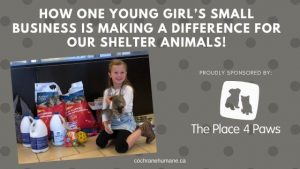
Seven year old Quinnley Bruce loves animals! In fact, she loves them so much she took donations for The Cochrane & Area Humane Society instead of gifts for her last birthday.
Last Christmas, Quinnley received a sewing machine. While experimenting, she began to make scrunchies. In case you don’t know what a scrunchie is, it’s a fabric covered elastic hair tie. Great for tying back medium to long hair! Quinnley made several using different fabrics and patterns and shortly they started to gain popularity when friends and family members wanted there own. That is when Scrunchie Q’s was born!
Quinnley, with the help of her mom now has her own successful business Scrunchie Q’s creating variety of hair scrunchies in all sorts of fun colours and every pattern you can imagine!
She sells her scrunchies on Instagram and also at the Cochrane Farmers Market and 10% of her sales are donated to the Cochrane & Area Humane Society! Quinnley loves that she is able to help the animals in her own way.
If you would like to support Quinnley and CAHS, please visit and follow her Instagram page and help spread the word for Scrunchie Q’s! Instagram: scrunchie_qs
Week 36: It’s not only about cats and dogs!

The Cochrane & Area Humane Society (CAHS) doesn’t only have cats and dogs in our care, we often have small animals like rabbits, guinea pigs, hamsters, and birds come through the shelter as well.
Often times, these little critters get looked over, but the can make fantastic family members too. As with any pet, they need proper housing, care, socializing and exercise time but due to their size and friendly nature, can be a great fit for many families. They also have some fun and quirky traits to show off when they feel happy.
Just like cats, guinea pigs make a quiet yet audible vibrating sound when they are happy, often when they are petted gently. In addition to purring, guinea pigs make a number of other cute sounds including “wheeking” (squealing). “Popcorning” is a unique behaviour more commonly seen in young guinea pigs when they are happy or excited. They jump up straight into the air over and over. Popcorning is unique to guinea pigs and is a really fun behaviour to watch.
Rabbits need social interaction, plenty of exercise and a lot of enrichment activities. They are very curious creatures who like to investigate anything new. When feeling silly, they might “binky” (a high, funny hop) to show you their happiness or excitement. Watching your bunny binky is sure to have everyone giggling!
Hamsters like to keep themselves clean and often groom themselves, just like cats! They love to explore tunnel toys and running on hamster wheels for exercise. Hamsters also love to bury into wads of soft nesting material to create their “sleeping’ caves”.
Consider adopting a small critter if they are the right fit for you. Not only do small animals give you companionship, but they have been shown to be psychologically, emotionally beneficial to their guardians as well. Caring for a pet can provide a sense of purpose and fulfillment and when you adopt from CAHS, you can also feel proud about helping an animal in need!
Keep an eye on our website to see what adoptable pets we currently have at the shelter.
Week 35: What’s in a name

Have you ever wondered how we come up with names for our animals? I would love to be able to tell you there is a well thought out process to ensure all of our residents are matched with the best possible name for them but I can’t. We totally make it up as we go along. We care for many animals in any given year…. that is a lot of names. Names that will follow them throughout their journey with us and in some cases for the rest of their lives. No pressure there.
The majority of animals arrive at our door without names and it is up to us to give them one. That awesome responsibility often falls to the staff member who does their intake or the volunteer who transports them to the shelter or the foster home who first cares for them. Litters and groups tend to have themes or start with the same letter, which makes it easier for us to know who came together as a group; the F pups, the Beatrix Potter bunnies, the flower kittens. We have called on Greek Gods, cities, trees, colours, deserts and desserts. You name it and we’ve probably used it. Our names can also reflect popular culture and we have had our share of Disney, Harry Potter and Game of Thrones characters. We utilize baby name books, personal experiences and Google. Lively discussions over names are not uncommon, everyone has an opinion and sometimes in an attempt to be unique we can go a bit too far. We once had a pretty little cat and her adorable kittens called the Mother Ship, HMS Acosta, The Santa Maria, CSS Hunley & SS Minnow, in hindsight probably not the best choices. Though well intentioned, spelling is not always our strong suit so we end up with Sza Sza rather than Zsa Zsa, and Vegabond not Vagabond. A name may need to be adjusted once the gender is confirmed; Gilbert becomes Gilberta, Jake becomes Jakelyn. Lloyd, Floyd and Boyd all turned out to be girls but we kept their names anyway and so did one of their new families.
Whether it’s Kitty Purry, Pawdry Hepburn or just plain Doug, we strive for every animal to have a personal connection with people, be it just a few or many. The longer their stay with us the more likely that their name becomes an integral part of who they are. At the end of the day the majority of animals will get new names to go along with their new lives and that’s okay. We realize that Susan and Not Susan isn’t as funny when they are no longer together, what’s a Bibbidy without Bobbidy & Boo and what the heck is an Eehmoo?
Some names will be forever tied to an animal that touched your heart. What’s in a name? Sometimes, everything.
Please visit our website to check out some of our quirky named adoptable pets: www.cochranehumane.ca
Week 34: Working at a shelter
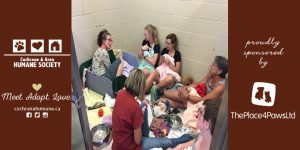
Ask anyone who works at an animal shelter, whether as staff or as a volunteer, and I bet they will all tell you that at some point they have been asked “How can you work there?” or “Isn’t it sad?” or “Don’t you want to take them all home?” The answers in no particular order are: No, I do and because I love it.
Animal welfare has come a long way in the last 20 years. Our shelter, and I’m sure the majority of modern animal welfare organizations, are not the stereotypical sad, dirty, dark places that you see in a commercial with a Sarah McLaughlin song in the background. We make magic happen on a daily basis, often with little more than good intentions. Our shelter is busy with limited funding. The staff and volunteers that work here are dedicated and hard working. They put their considerable talents to work for a cause that they believe in and are passionate about, and their reward is… hard to explain at times but let’s give it a shot.
Isn’t it sad? At times yes, but most days not at all. There are tears, but there is also compassion, empathy, joy, and lots of laughter. I challenge you to sit in a room with a bunch of kittens or puppies or watch a rabbit binky and be sad. Can’t do it. The conversations you overhear in the building alone will make you chuckle; many involving bodily functions, fluids or colourful names for body parts. Who knew there could be so many discussions about poop and parasites? We are hands on with animals that come to us from a variety of backgrounds, but they all have one thing in common; they need us. So we come in, roll up our sleeves and get to work. Dogs to be walked, cats to be brushed, bunnies to hop. WC Fields famously said, “Never work with children or animals.” Sure, they can hijack your day and steal the limelight, but they also keep you grounded and make you smile.
Don’t you want to take them all home? Sometimes, but even those of us with hoarding tendencies eventually realize that you can’t. Do some of our volunteers and staff add to their family with shelter animals? Absolutely. Does everyone? Absolutely not. There are some that get a bit further into your heart than others, but we realize that we are part of their journey and not necessarily their destination. Our job is to get them ready for the rest of their lives and there can be a huge amount of satisfaction in that.
How can you work there? Easy. There is a sense of community in being in the company of people working towards a common goal; a sense of acceptance and peace in working with animals on a daily basis; a sense of pride in making a difference, however small, in the life of an animal. There are so many moments that make us smile and laugh that help carry us through the tough times. Most days there is nowhere else we would rather be.
Week 33: Humans aren’t the only ones who experience stress
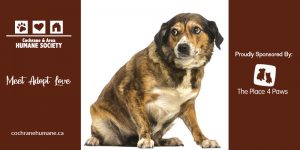
You know that feeling you get every time you see a new dog? That somewhat uncontrollable urge to run over, scoop that pup up and snuggle it for hours.
As tempting as it may be, think about it from the dog’s point of view, scary right?
Dogs are naturally predisposed to run from danger when needed. Whenever we hug our dogs we are depriving or preventing them from that ability. In some cases, it can stress your dog to the point that they may actually react negatively.
Stress is the body’s reaction to a change that requires a physical, mental or emotional adjustment or response. Dogs who experience behaviour concerns such as fear, reactivity or anxiety tend to be in a high state of stress.
Putting a dog into a stressful situation will inhibit clear thinking and activate the dog’s emergency response system (the flight or fight system).
However, with dogs that suffer from fear and/or reactivity concerns, it is important that we understand the effects of stress and what stress looks like.
Pay attention to their body language and the signs of stress that can include baring teeth, ears pulled back against the head, wide eye gaze, avoiding eye contact and lip licking. Chronic stress can have negative impacts on your dog’s health and it’s important to minimize their exposure to stressful events and work with them through their concerns.
We can all do a better job of observing and learning the signs of stress with the dogs in our lives. When you see a stressful reaction, try to resolve your dog’s concerns and make them more comfortable. This can include incorporating treats and teaching the dog that the situation or person or animal is a positive experience versus something to be concerned or anxious about.
The Cochrane Area & Humane Society often offers seminars and training classes on helping you and your dogs in various situations, check our website for upcoming events and learn all the tools you need for success at beating stress!
Week 32: Why fundraising is so great for children

Kids don’t have to be excluded from fundraising, in fact they shouldn’t be. Encouraging children to raise money for charity is a great way to teach them social responsibility and how their actions can really make a difference to others. It can instill the values of charitability and generosity. Fundraising can also provide some tangible learning opportunities for students. Talking to potential customers, tracking orders, handling money, and delivering goods, can teach kids lessons that will benefit them in other areas of their lives. Children may gain confidence, improve communication skills, learn about personal responsibility, and practice their math and financial skills, to name a few. While helping with these skills certainly won’t be a primary goal of your fundraiser, you might consider incorporating them into your plan as an extra benefit. It’s easy to see how students can learn customer service skills from participating in fundraisers. Smiling, making eye contact, and using clear, direct speech are all skills kids need to develop to help them later in life. Fundraisers show them the significance of presentation, setting and reaching a goal, and accepting responsibility for completion.
There are plenty of unique fundraising ideas and events that will encourage kids to get in the spirit of giving while having fun running around, playing, and raising money for a fantastic cause. The Cochrane & Area Humane Society (CAHS) often has children who have raised funds from their birthday parties or lemonade stands and one recent donation from Matt Fisher who raised $1000 fixing bikes over his summer vacation. We couldn’t do what we do without our wonderful volunteers and all the kids like Matt, who work so hard to raise funds for the shelter.
Helping children create a fundraising campaign that meets a personal as well as charitable goals and help keep them maintaining a positive attitude, having friendly competition and be resilient for whatever life’s future has to offer!
If you are looking for ideas or different ways to help donate to the shelter, please visit our website or contact the shelter during public hours.
http://www.cochranehumane.ca/donate/support/
Week 31: When your pet is approaching the end of their life

It’s never easy to find out that your pet may be approaching the end of his life, but pet owners can feel some relief knowing they can ease their pet’s transition to the rainbow bridge.
Coping with the impending loss of a pet is one of the most difficult experiences a pet parent will face. Whether your furry friend is in his golden years or has been diagnosed with a terminal illness, it’s important to help guide them in their end-of-life experience and minimize any pain, discomfort or stress.
One of the first and more important things you can do while your pet’s health is declining is to manage his pain. While people show outward signs of distress such as tears or facial expressions, our pets expressions of discomfort are usually much more subtle like panting, social withdrawal, reluctance to move and loss of appetite. Once you recognize your pet is in pain, you should take him to the vet to diagnose and help manage any health problems. This is especially important because an untreated illness can lead to unnecessary or rapid declines in your pet’s health.
After seeking guidance from your vet, you can work to minimize any discomfort or emotional stress your pet is experiencing. Surround him with his favourite toys and a warm blanket. Some ailing pets may experience limited mobility and can develop loss of bladder control. This is the time to ensure your pet has plenty of soft bedding and an easy way in and out of his space. Be sure to check your furry friend regularly for any wetness or soiling. If your pet needs help getting up, you can use a towel to wrap under his body and assist him.
When your pet’s quality of life deteriorates due to an untreatable disease or aging, please speak with your veterinarian and family members about end-of-life issues and options to ease your pet’s suffering.
The Cochrane & Area Humane Society (CAHS) believes every animal deserves a chance no matter how old or what their medical needs may be. Our Compassion Care Program has become almost a promise to the animals we serve that says just because they are old or sick doesn’t mean that their life is without value. If there is still quality in their lives then there is a place for them with us and people that will do their best to make their last months or years worthwhile. We are privileged to have the opportunity to make a difference in those animals’ lives and the lives of all the animals we care for.
If you would like to help the Compassion Care Program, your donation will provide these animals with the medications, special food and surgeries to let them live out their lives with dignity. Thank you to Global Pet Foods who sponsors this wonderful program.
Week 30: Common Ground Creates Opportunity for Solutions By Janaia Hutzal

It is through the commonality of love and compassion for animals, along with getting to know the needs of each of its individual communities that the Cochrane & Area Humane Society (CAHS) is able to create solutions to generate positive change.
When the CAHS staff and volunteers make community visits; whether that is to a store, an event or to lend a hand up, it is done with this common ground in mind. Each visit is a chance to promote animal adoption and an opportunity to educate on the importance of spaying and neutering, vaccinating, pet health and safety.
For the past twenty years, staff and volunteers from the CAHS have made weekly visits to the Stoney Nakoda First Nation community providing food donations for those in need and other means of support.
Janine Rossler, with the CAHS, was fundamental in initiating the program. She says the visits are important because the Nation does not have onsite veterinary or animal welfare services.
“Over the years, hundreds of dogs and cats have been spayed and neutered, provided with permanent identification, the benefits of vaccination and parasite control,” says Rossler.
Hundreds of surrendered pets have also had the opportunity of rehoming through the shelter’s adoption program. And, like all community visits, it is a great way to build a relationship with and educate each person they come in contact with.
“We want to offer a reliable and trusted presence accessible to community members and provide continuity of support on a weekly basis – rain, snow or shine.”
Sheila French is a CAHS volunteer who has seen first-hand the positive improvements in the condition of the animals.
When it comes to surrenders French says, “Lots of times they’re in tears and we’re in tears; it’s very sad.”
Every day the CAHS receives animals from those in our various communities for many reasons. A humane society’s job is not to judge the “why,” yet it must be asked to help with creating future programs for prevention and for the immediate care of the surrendered animal. Most importantly, the shelter offers a trusted promise to do its best for each animal that comes for a shelter stay.
Whether at home, work or out in the community, realizing common ground is the first step in laying positive groundwork for positive change in the entire world – the animal world included.
Thank you to The Place 4 Paws for sponsoring our weekly blog.
Week 29: Unfriendly Flowers
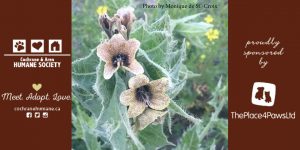
Summer vacations are always a fun time for furry friends and family members to explore and enjoy the great outdoors. Pets also need their owners to be their protectors and advocates when it comes to some of nature’s elements that may be harmful or cause stress, like squelching heat, loud thunderstorms and also poisonous plants.
When Monique de St-Croix was hiking in the Spray Lakes region, she came across Black Henbane, which is known to be toxic to many animals. de St-Croix contacted Cochrane & Area Humane Society because it is an area that our shelter animals occasionally visit with our Hiking with Hounds volunteer group. She is now working with the Town of Cochrane to plan a weeding party to remove some of these unsafe plants in common areas where our pets and your pets walk.
Signs that your pet may have been exposed to a poisonous plant are vomiting, difficulty breathing, excess drooling, diarrhea, agitation, skin irritation and even heart issues.
According to the Humane Society of Canada (HSC) some of the common plants that are toxic to pets are: buttercup, chokecherry, daffodil, eggplant, foxglove, lily-of-the-valley, philodendron, tulip, rhubarb, English ivy and rhododendron. Yet many plants and herbs can be toxic to animals when ingested in high amounts. The American Society for the Prevention of Cruelty to Animals (ASPCA) has a list with photographs of plants to watch for and their toxicity levels. If you are unsure about a plant or if your pet shows signs of toxicity, please contact your veterinarian.
Week 28: Choosing a Dog Trainer for Positive Results
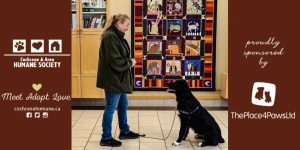
There are as many boxes to be checked off before signing your dog up for an obedience or training class as there are different types of dog trainers. To help make a decision, the first question to ask a potential trainer should be, “How do you modify behaviour?”
The answer you are looking for is positive reinforcement and reward-based methods, where the dog is set up to succeed and then rewarded for performing the “good” behaviour.
This type of training makes learning enjoyable for the dog and enhances the relationship between the dog and handler. While looking for the word positive, be sure that it is used with reinforcement and not “positive punishment,” which is decreasing a behaviour by adding something – often pain. Avoid trainers who use words such as dominance, intimidation and aversive tools, such as prong or choke collars.
A study published in the Journal of Veterinary Behavior on the effects of using aversive training methods in dogs, showed that these methods can “jeopardize both the physical and mental health of dogs” and that positive reinforcement is more effective.
Because the dog industry is not regulated, it leaves the door wide open for self-proclaimed trainers, some of whom charge large amounts of money for little results. Falling into this trap can be avoided by checking credentials and speaking with past clients.
When inquiring about certifications, again be sure that the organization of affiliation is also positive reinforcement based. You can contact the organizations themselves, some of these include: Certification Council for Professional Dog Trainers (CCPDT), The Association of Professional Dog Trainers, Karen Pryor Academy for Animal Training & Behaviour, or the International Association of Animal Behavioural Consultants, and ask for information about their standards and about the dog trainers in your area.
Whether you are bringing an older dog or new puppy into your family, one of the best ways to build a lasting bond of trust is through understanding. A good dog trainer will demonstrate a strong understanding of animal behaviour, signals and body language.
As much as you are doing your homework about your trainer, the trainer should also be asking questions about your dog. Past history can provide crucial information when handling a dog. For serious behaviour issues, experience and expertise are important. Some trainers specialize in specific behaviour problems, while others won’t handle issues such as aggression.
Once enrolled in a class, the tools learned can be brought back and taught to the entire family. Whether or not you would allow a child to perform or apply the methods being taught, may also help direct your choice of trainer. Remember, if it doesn’t feel right it probably isn’t.
All instructors at Cochrane & Area Humane Society (CAHS) are certified through the CCPDT, which requires passing a comprehensive exam, have at least 300 hours of dog training experience and regular recertification. Positive Approach Canine Education (PACE) is the training program offered at CAHS, and is designed to assist in preparing students to become certified through the CCPDT.
Week 27: Sharing is Caring

Education is not only important to the Cochrane & Area Humane Society (CAHS) for our own staff and volunteers, but it is part of what creates a strong community of animal advocates who can continue to work and play together. Changing and saving lives begins and ends with education. This involves knowing how to practice responsible pet care at home and in public places.
On June 9, Tracy Keith, CBCC-KA, CPDT-KSA, as well as CAHS’ executive director and co-founder held Off Leash Dog Park Seminar in the CAHS Rehabilitation and Education Centre, sponsored by Global Pet Foods Cochrane.
One of the comments from a seminar attendee was, “I felt the seminar was well done and offered the information I was hoping to learn. I think this seminar should be mandatory for all humans using dog parks!”
We agree. Because behavioural problems are the most common reason why people surrender their dogs, understanding animal behaviour is a key component for success.
This fall the CAHS will be holding two more educational seminars. Speak Dog, which is on September 17 from 6:30 to 9 p.m. is now taking registrations. You can find all of our upcoming events and seminars on the CAHS events page. For your own animal enjoyment, and your own animal, we hope you will consider attending one of these upcoming seminars.
Week 26: Extraordinary

Once a month our shelter van with two staff members or volunteers drives out to rural Saskatchewan to bring back rescued animals in partnership with Canine Action Project (CAP).
Earlier this year, Four Feet Companion Foundation generously donated $3000 to help our rescued animals from our Rural Rescue and Support Program (RRSP), sponsored by Pet Valu Cochrane, who are in need of extraordinary medical care.
Three of the precious animals that have been saved because of this grant are Ethel, who had a mammary tumour removed, little Bonzai who was treated for severe mange and ticks, and Zeke, an amazing story of a special life that has been saved that began with a phone call from rural Saskatchewan.
Zeke had a severely injured leg and needed our help. Because of his size an amputation would have been difficult on Zeke, which left little options and even less time. Karla, Cochrane & Area Humane Society’s Operations Manager, offered to drive out to meet at the half-way point and bring Zeke back to the shelter. Because of this grant our vet hospital could afford to call in a specialist, Dr. Remedios, who came out the next day and surgically placed a stint in Zeke’s leg.
We are happy to say the Zeke and Bonzai have found their forever homes. Ethel is still waiting to be adopted, if you would like to meet our sweet Ethel, please contact our adoption specialists at adoption@cochranehumane.ca
Thank you to all who support and donate to the Cochrane & Area Humane Society, and the Four Feet Companion Foundation. Through your generosity, these precious animals and many more have been given a second chance at a happy and healthy life.
Thank you to The Place 4 Paws for sponsoring our weekly blog.
Week 25: Against All Odds
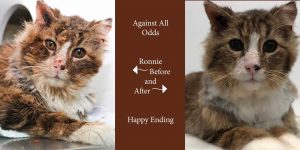
It was a picture on the Cochrane & Area Humane Society’s (CAHS) Facebook that drew her in. Even though Kathrynn Penner wasn’t actively looking to adopt a cat, she says there was “something about his face.”
“He was scruffy, matted, and crusty, but there was a weird sort of rugged charm to him,” says Kathrynn about the CAHS rescued cat, Ronnie, whom she has now renamed Churchill.
After finding herself talking to her coworkers about him, she finally came by the shelter to meet him, and there he was, “waiting” for her in the doorway of the cat room.
“Sometimes it’s pretty obvious when things are just meant to be.”
Kathrynn works at a local veterinary clinic, so she knew that an older pet would better suit her life, but she had prepared herself for the worst when it came to bringing him home because he looked as though he had not been in a home for a very long time, or perhaps never. He also has no teeth and was soon diagnosed with early stages of kidney disease.
But Kathrynn says that what most people don’t see is how perfect Churchill is for her and how he has been her little “shadow” since day one.
“For someone who’s owned pets her entire life and only had a bond like that a handful of times, it’s enough to bring me to tears and not something I never expected to experience with him.”
Kathrynn says that she knows she won’t get as much time with her Churchill as she will want because of his age, but she knows that every day she has with him is a gift.
”Pretty incredible for a toothless, frostbitten old tomcat.”
Thank you to The Place 4 Paws for sponsoring our weekly blog and to all those who continue to bring out the best in the animals you adopt, even when it is against all odds.
Week 24: #ShowSomeLove

What a fabulous show of love from our wonderful puppies, and just as wonderful volunteers, towards the Calgary Stampeders near the end of their training camp. On June 5, our Cochrane & Area Humane Society (CAHS) team spent the afternoon at McMahon Stadium with the 2018 Grey Cup Champions, showing our support for our wonderful athletes. It was a definite win-win to see the players soften and smile the minute they took a puppy into their arms, just confirming the many studies that have proven the calming benefits animals can have on their people.
At the event, Calgary Stampeder, Terry Williams, told Stampeders TV that having the puppies there was a great break from the stress of training camp.
“Dogs don’t yell at you, they don’t judge you, they don’t say anything; they’re just cute and fluffy,” said Williams.
We were very proud to share the best of the CAHS with the best of the CFL. And we are excited to #showsomemorelove!
The CAHS is excited to be teaming up with Kendra Watt, with CIR Realty, and the reigning Grey Cup Champs, the Calgary Stampeders.
Meet the 2019 “Clubhouse Pup” who is being fostered by Kendra Watt and the Stamps, soon to be named by the fans.

This sweet little guy came to us with paws that did not form properly. He is a perfect example of our belief that every animal deserves a chance – and what a chance he is getting! At each Stampeders home game our special “red and white” pup will be shown on the big screen spending time with his big foster family, the team, while he continues to receive any further training and medical care he requires from the shelter.
Thanks to Kendra and the Stampeders we will be able to bring a greater awareness to the importance of caring for all animals with compassion, as well as expand the CAHS invitation for animal fostering and adoption.
Watch for upcoming events where you can meet and get your photo taken with our famous pup. And be sure to mark on your calendar to join us a for the Stampeders tailgate party in the Fan Zone before the Labour Day game on Sept. 2, where you will have a chance to win his first jersey signed by the team.
We hope you join us this season as we continue to cheer on our special pup, our great team and all of our animals and athletes by supporting every champion that comes into our shelter.
Follow the foster pup’s journey on Facebook, Instagram and Twitter at @cochranehumane, @kendrawatt_realty and @calgarystampeders.
Week 23: Adoption is Natural

A great example of perseverance was show by our little orphan kitten, who came into the shelter only hours old, who was adopted by an expecting cat named Sprite.
For Cochrane & Area Humane Society’s (CAHS’s) foster mom, Diane, it all began in the laundry room.
“Next thing I know, CAHS Animal Care staff are telling me that there are two 12-hour-old kittens that were just brought into the shelter,” recalls Diane.
Diane gathered the items she needed from the shelter to syringe feed the kittens and brought them home, keeping them warm and close to her body. Sadly, within hours one of the kittens passed away, which, Diane says is always the hardest part of fostering.
“I called her Ma Petite. I’ll never know why she passed; what I do know, is she was loved very much. You never ever forget a single one that you lose.”
But there was still one more kitten who needing to be cared for. Diane named her Ma Chéri.
Shortly after, a very pregnant Sprite came into the shelter and was also taken into Diane’s home. Diane was given permission by CAHS’ veterinarian, Dr. Charlene, to add the kitten to the litter once the babies were born – or even before.
The night before Sprite delivered, Diane was holding the kitten and Sprite came and took Ma Chéri right out of her hand and began grooming and caring for the kitten like she was her own.
“It was so amazing to see.”
Ma Chéri continues to thrive thanks to her adopted cat-mom and her very caring foster mom. Gratitude goes to all for this beautiful story of perseverance. Our foster homes make such a difference in the lives of our animals by offering a nurturing place where the animals can flourish. If you are interested in opening your home to foster please contact foster@cochranehumane.ca or apply today at https://www.cochranehumane.ca/volunteer/apply-now/.
Thank you to The Place 4 Paws for sponsoring our weekly blog.
Week 22: Special Means…

The word special has various definitions: better, greater, different from what is usual or exceptionally good or precious. Every animal that comes into our shelter is special in that they are precious, but we have some who have needs that are different or beyond what is considered usual. To us, these animals are very special and those who adopt them are even more so.
When Keely Booth and her Edmonton family saw a video of our one-eyed basset hound, Ladybug, running down the hall after recovering from painful glaucoma that resulted in an eye removal, something in their hearts told them they could be the ones to provide this lucky lady a loving home for however many years she has left.
Keely was taking a break from her normal work-life that had involved a lot of travelling and the family had always wanted to adopt a geriatric dog; the timing was perfect. The next day they drove to the Cochrane & Area Humane Society and took our lucky Ladybug, 9, home forever.
Recently Ladybug’s other eye area started to swell. This was something that, although the family hoped would never happen, they had been prepared for. They immediately took her to their vet who treated the oncoming glaucoma aggressively with medication. After a few tears and a couple of very long days of worry, when they took Ladybug back to the vet for a follow-up, they were happy to learn that her eye could be saved, though some vision was lost.
Keely says that having Ladybug in their lives has been the “biggest blessing” and they hope they will be able to love her for another ten years.
Other than Ladybug’s vision, some missing teeth, needing a few lifts up here and there, and some tattle-tailing the way a hound dog can when one of the four cats steals her geriatric food, the family says that their new BFF is not a lot of work.
“She only likes short walks – and she likes long naps.”
While Ladybug was undergoing her recent flare-up of glaucoma, Keely said that no matter what happens, they will never regret adopting this special lady because of the love that she has brought into their lives.
When people tell the family how lucky Ladybug is to have been adopted into such a loving home, Keely’s response is, “We’re lucky; we get to have her probably at the best of her life.”
Week 21: A+ and Many Thanks to Our Wonderful Teachers

As this school year is winding down, from all of us at Cochrane & Area Humane Society (CAHS) we would like to send a big thank you to the many teachers in our communities and beyond.
This year we have been graciously thought of by wonderful teachers, who also change and save lives daily, and involved our shelter animals in their classrooms in various ways. The tremendous support from schools begins with these classroom leaders and our community of children continues to grow because of their support.
Calgary Art teacher, Becky Carruthers, shared photographs of CAHS’ adoptable animals with 84 grade four students, who then painted their animal. The finished project, which Carruthers named Empathy Pawject, was displayed at Calgary’s new Central Library. It was touching to see our animals viewed and painted through the eyes and hands of children. The project raised $991 for our shelter.
CAHS’ continued support of youth is a step forward in targeting some of the greater issues in society by showing empathy, compassion and kindness. Thank you to the many classrooms who have visited our shelter or invited us to visit them this year, and to those who raised money for our shelter animals in unique ways.
Grade five students from Cochrane Fireside School raised $2000 for CAHS through their hands-on project based learning assignment that involved creating business plans and holding a market. Compassion combined with innovation is what our world has to look forward to in these amazing students thanks to great teachers!
And on May 29, CAHS was invited to attend Celebration of Learning for Building Futures with Grade ten students, Kingmsith Homes and teachers Darryl Korody and Matthew Chomistek. It was a fabulous community event with a great turn out by those who came to see all that the students had accomplished this year – and it was very impressive! The students worked with Craig Wiens, owner of Kingsmith Homes, and not only built two homes, but also a two-dog-house that they have donated to CAHS for our November Wags and Whiskers Gala to be auctioned off. That day, these hardworking students, also raised $400 in hotdog and hamburger sales for our shelter animals.
Thank you to all of our classroom and community students and teachers for continuing to build great futures. We hope you have a the wonderful summer you deserve.
Week 20: To Love a Barn Buddy

As much as cats are known to laze in the warmth of the sun, they also love to keep busy and have a purpose. For barn buddies, a productive day involves a good mouse chase.
About five years ago Jaime Wrightson adopted Cadence from the Cochrane and Area Humane Society (CAHS) because of her “street cred.” Wrightson needed a “mouser” and Cadence was used to being on her own in the outdoors.
As an animal lover it was also important to Wrightson that her new friend was cared for.
When Wrightson first brought Cadence to her new home, they did not see her much. If it weren’t for the food that would disappear, they may not have known Cadence was there.
“Now she loves attention and will talk your ear off with her stories,” says Wrightson about their once feral cat, who has now become part of the family.
Outdoor cats are often essential in rural dwellings as a natural way to get rid of mice. This is their life and where they are most comfortable. Because of their independence, they don’t ask for much; however, they do like their hard work to be noticed. Barn cat owners will occasionally receive a gift on their doorstep of a mouse or rodent they caught.
Owners can show their appreciation for their hardworking feline friends by doing their part in ensuring their outdoor pet is provided with adequate food and water, shelter and safety. It’s also imperative that responsible pet care is practiced by ensuring outdoor cats are spayed or neutered, vaccinated, receive identification and any other veterinary care when needed. This is all given to our cats before adoption.
When cats come into the CAHS, we first determine their level of human interaction to help us find them the best suited home. Kittens and the majority of our cats are placed into permanent indoor homes, but there are some exceptions.
With consideration given to each cat’s history and level of socialization, a cat may be adopted out as an outdoor pet. These fall into two categories: companion and non-companion barn cats.
Companion barn cats are those who are not suitable to be a house pet, but would do well living in a heated or insulated barn or out-building.
Non-companion barn cats are those who have not had previous human interaction and are sometimes known as feral and are fearful of humans.
Overtime, many outdoor cats come around as trust is built with their people, just as Cadence did.
Recently two non-companion barn cats, Jack and Ash, came into the shelter together and fortunately it did not take long before they were adopted together. After being slowly introduced to their new barn environment, with a soft blanket, food and water, they are finding comfort in their new home.
Shelter life is very unfamiliar for these special performers, so we strive to find them a home as soon as possible. If you are looking for an outdoor cat to add to your rural residence, please visit the shelter, we might just have the perfect barn buddy looking for you.
Week 19: Catification

Although the process began long before through thoughtful consideration and generous support, Cochrane & Area Humane Society (CAHS) underwent renovations to our cat and small animal areas over the past number of months. The team who headed up this project, which we called Catification, consisted of CAHS management, five dedicated volunteers and very much appreciated donors who made this project possible. And, as always, it couldn’t have been a success without many helping hands.
In 2018 almost half of the 1893 animals we cared for were cats. Some were previously owned and some were not, yet what they all had in common was that when they came to us, they were homeless and needed a safe, nurturing and comfortable place to be their temporary home while they waited to adopted into their forever families. Catification was initiated by a desire to create an even more enriching environment for all of the cats during their stay at the shelter.
In January a large delivery from the United Sates full of new cat suites arrived at the shelter. This delivery consisted of $80,000 worth of new cat condos, which were specially designed and constructed for CAHS by Shore-Line, who specializes in enriching animal care arrived at the shelter. Thanks to our many staff and volunteers who worked long hours, all of these new suites were put together and moved into our cat rooms. Some of the older ones went to our holding area for our new arrivals.
The new suites feature similar amenities to the original ones, only these had a larger footprint. Some of the keys features that are important for cats to have in their enclosures are a separate litter area, a place to retreat to/hide, multi-levels and room to practice all nature behaviours such as arching, stretching out, fully erecting tails. Also important are Kat Kaves, or hiding boxes, to provide a visual barrier when cat wish to be out of the public eye and have some quiet time. The new suites accommodate all of those.
Another part of the Catification project was to give the rooms themselves a fresh look with soothing yet uplifting colors that were welcoming to the people who visit. Each cat room and our small animal room received a new coat of paint of either lavender or apple green. The floors in the area were also in need of an upgrade and were replaced with a brighter and near seamless material.
All of our cats were temporarily moved into the Resource Room or placed in foster care while the major work was being done. Our shelter was only closed for a couple of days while the floors were put in by Riverbend Interiors. Our warning sign for all workers who entered was not of unsafety, but to beware of the irresistibility before you enter that you may go home with an adopted animal! Two of our dogs, Midas and Jess, were both adopted by men working with the flooring company.
The final part of the project is yet to come. Here we will be continuing to outfit each room with enrichment in mind during playtime. This may be different types of cat trees or perches, multi climbing levels around the room, lounging areas and new toys & scratches. The Catification committee is still working on this part of the project, along with our many volunteers who spend time with our furry felines, because playtime is a big part in offering our animals enrichment.
CAHS is happy to be teaming up with Airdrie and Cochrane Pet Valu stores where they will be accepting enrichment items for our animals that are purchased at their stores and will match each item up to $500. For a list of enrichment items we are in need of please visit our Wish List Page. Thank you Pet Valu Airdire Coopers Crossing, Pet Valu Airdrie Main Street and Pet Valu Cochrane.
Week 18: Humane Helper to Humane Hand – Thanks Mom!

Browen Lawton who is now 23-years-old began volunteering at the Cochrane & Area Humane Society with her mom, Marla Johnson, in 2009, the very first year the Humane Helper program was launched. Browen, who was involved previously through the CAHS Kids Club when she was still a toddler, is now working at the shelter as an Animal Care Specialist.
CAHS: Did you and your mom start at the same time? Whose idea was it?
Browen: Yes we did. It was an idea that she came up with but I pushed her towards—I wanted to do something with animals so my mom decided to look into the CAHS Kids Club. When the Humane Helper program came around, it was the perfect opportunity for us to take the next step in our volunteering journey. My mom is allergic to most animals so being involved with the CAHS let me get my animal fix without having to bring one home.
CAHS: Why did you decide to get involved together and what did you learn about your mom and about yourself through your mom’s example by helping out at the shelter starting at a young age?
Browen: I’ve always been an animal lover and endeavour to be gentle and patient with any animal I meet—from a young age, my mom taught me to hold even my stuffed animals with care and compassion. I was too young to volunteer on my own at the time, so despite her allergies, my mom still wished to volunteer with me as she too loves animals. When volunteering, she made sure that we always finished our work before playing with the animals, ensuring everyone was taken care of before taking them out to play. It taught me to work hard and not neglect the animals’ needs, preparing me for taking care of my own animals once I was old enough to move out and adopt my own!
CAHS: How did volunteering as a youth shape your future?
Browen: Volunteering and being involved with animals from a young age solidified my decision to work with them, specifically with less-fortunate pets, as a career. I have always been involved with animal rescue even when I was not actively volunteering with the CAHS, be it through volunteering at the Edmonton Humane Society as I completed my BSc in Animal Health or working with other animal rescue and wellness organizations such as Zoe’s Animal Rescue, Alberta Helping Animals Society, and Chimo Animal Assisted Wellness and Learning Society through the courses I took.
CAHS: Can you share something special about your mom?
Browen: My mom battled aggressive stage 4 NH Lymphoma the winter before last. She underwent aggressive chemotherapy but is now officially one year cancer free! Many people don’t know she is newly post-chemo so she is enjoying being treated normally. She is glad to be able to get involved again without having to worry about her compromised immune system and is very happy to be back volunteering at the CAHS with me. 🙂
Thank you Marla for combining your love for animals with your love for Browen.
For more information about becoming a CAHS Humane Helper please contact volunteer@cochranehumane.ca or visit our Kids Page to learn about our education programs, PJ Parties, Birthday Parties and the many ways your child can get involved at the shelter.
Week 17: OFF LEASH DOG PARK SEMINAR
What You Should Know If your Gonna Go!

The Cochrane & Area Humane Society (CAHS) is offering an informative community seminar on the many elements of off leash parks on June 9, 2019 from 1 p.m. to 5 p.m. presented by Tracy Keith, CAHS’ co-founder, executive director and head of CAHS’ behaviour department.
Participants will gain a solid understanding of what the effects on a dog can be by exposing them to a dog park environment. Presented with live video footage, the seminar will focus on safety, when and where one is most likely to run into challenges and how to handle and manage those challenges to prepare pets for the best dog park experience. It will also offer understanding on which dogs may or may not be good candidates for the dog park.
The goal is to help reduce reactivity in dogs caused by inappropriate interactions at off leash dog parks and to help keep dogs and people safe while in the dog park environment. Participants will learn how to read and monitor dog body language and when and how to safely interrupt dog interactions. The seminar will also focus on the benefits of a solid recall and strong name attention achieved through positive reinforcement training and the pitfalls of using punishment at the dog park, in training, and in general. Through a solid understanding of canine play styles, what an appropriate dog to dog meet looks like vs. a rude greeting, off leash parks can continue to be a place of social enjoyment for animals and owners.
The cost is $50. This seminar, which will be held in the CAHS Rehabilitation & Education Centre, 62 Griffin Industrial Point in Cochrane, Alta. is valuable for all dog owners and has also been approved for 2 CEUs for trainers CPDT-KA and behaviour consultants CBCC-KA and 4 CEUs for IAABC. Registrations can be made online at http://www.cochranehumane.ca/off-leash-dog-park-what-you-should-know-if-youre-gonna-go/. The seminar is proudly sponsored by Global Pet Foods Cochrane.
After over 20 years of experience working with every dog type and personality, Keith offers community seminars to continue CAHS’ mission of saving and changing lives in and out of the shelter, which begins with educating to grow a culture of animal compassion and understanding.
“Opening up the lines of communication between pets and their people seals the human/animal bond,” says Keith.
“It all begins with using positive reinforcement science based training techniques and becoming proficient at reading canine body language. People who have dogs and go to off leash parks should understand what the dogs are saying to each other and also understand the benefits and disadvantages of visiting public dog parks. I created this seminar to help people be the best they can be in parks and to set their dogs up for success at every visit.”
Founded in 1998, CAHS leads and inspires communities to value and treat animals with respect while participating in initiatives that reduce indifference towards, suffering of and overpopulation of animals. CAHS relies on community generosity through monetary donations and volunteers. Giving back, through various forms of education, is a major part of CAHS’ success. We hope to see you there!
Week 16: Happy Mother’s Day!

Here are some fun and amazing fun facts: Cochrane & Area Humane Society (CAHS) presently has 34 Humane Helpers and another 25 who are on their way! Humane Helpers are special young people, ages 13 to 15, who come to the shelter with an adult, parent or guardian. Majority of our Humane Helpers come with Mom.
During this special month of celebrating our mothers, CAHS has much to celebrate. Thank you to all of our volunteer moms who come to the shelter with your children to help care for our animals. Thank you for all of the nurturing and love you offer daily to your own babies – and to ours. Through your example of care and compassion our shelter animals will forever be shown much love.
Hannah, 15, who in the beginning was the one who wanted to become a volunteer for CAHS because of her love for animals says she has come to learn how much her mom does as well.
“She loves fostering dogs and spends a lot of time with them,” says Hannah about her mom.
Over the past five months the duo has been volunteering together at the shelter once a week and have already fostered three groups of animals. Soon Hanna will be 16 and able to volunteer herself, but for now, this mother-daughter duo is enjoying sharing this form of giving together.
Sadie, 15, and her mom Tonya have been volunteering at the shelter spending time enriching the lives the lives of our shelter cats. Sadie says that she has enjoyed the past year of volunteering with her with her mom and likes that it gives them something special that is their own to talk about at home. She has learned that her mom is much braver than she thought and she is impressed at how she is able to calmly handle emergencies. Sadie says she has seen a very compassionate and gentle side of her mom and appreciates being able to see her in a different environment.
“That’s pretty cool,” says Sadie.
Monika and her twins, Paige and Peyton, who are the youngest siblings in the family, come together to the shelter on Friday evenings to lend a hand. These young people and their mothers are another example of how fortunate CAHS is to have such great moms who are making the world a better place by spending time raising such great children and for all that they do for the shelter and our animals.
Happy Mother’s Day to all of our very cool and special Moms!
Week 15: HOW TO MAKE A SNUFFLE MAT
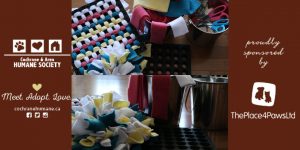
Snuffle Mats can be used for many purposes and for all types of animals. Depending on the animals’ needs, a Snuffle Mat can be a toy, a soft place to snuggle or a method of offering food or treats that takes time for the animal to find, while also having to use their instinctual and tactile skills. These are all examples of ways of providing your animal with enrichment.
Make your own Snuffle Mat at home by following these simple steps:
STEP 1
Start with a Hex Tile Rubber Mat or other plastic mat with holes. These ones were found at Canadian Tire. For smaller Snuffle Mats, you can use plastic sink straining mats. Cut the rubber to the size appropriate for your animal.
STEP 2
Choose a fleece fabric or old fleece blanket and cut 8 to 10 inches long and 1 to 2 inches wide.
Loop the fleece through the hole and tie one knot at the top. One knot is enough.
You can choose a colour pattern or tie randomly, be creative!
STEP 3
Be sure to loop the fleece fabric around each hole in each direction to fill as many gaps as possible.
Tying slightly looser knots can help fill the holes.
And tada! Your Snuffle Mat is ready to be enjoyed by your furry friend!
Snuffle Mats can be purchased at Cochrane & Area Humane Society in Norm’s Nook. Come visit us today!
Thank you to The Place 4 Paws for sponsoring our weekly blog.
Week 14: Animal Enrichment for Life
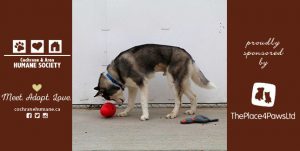
Animal enrichment is a process for improving the environment and behavioural care of animals within the context of their individual needs. By offering opportunities that create pleasant internal responses, the animals’ tendency towards making their own positive choices is strengthened.
Providing enrichment is foundational and supplementary to all behaviour work done with animals at the Cochrane & Area Humane Society (CAHS). It is as essential as nutritional, physical and medical care.
CAHS’s Enrichment Program, which is sponsored by Cochrane and Airdrie Pet Valu stores – where each enrichment donation made is matched by the store – not only enriches animals’ stays, but it also sets them up for long-term health and happiness. CAHS staff and volunteers track what works best for each animal to meet his or her needs. This information is shared with the new family as going to a new home will involve another environmental adjustment.
You can provide your own animals at home with opportunities for enrichment. If your pets are reacting, appear stressed or show signs of anxiety, immediately seek to discover what it is they need. Is it more exercise, more quiet time, opportunities to sniff, chew or play? Perhaps they need more or less social time with other animals or some quality human time.
The enrichment must meet the individual needs of each individual animal. This can involve everything from daily dog walking to play-time with other animals, or a good old game of hide and seek with family. Animals also benefit from soothing music, meditating with their people and relaxing reading time. Allow dogs to be themselves and to practice natural behaviours such as chewing or sniffing. Taking in the sounds and sights of the great outdoors can be as beneficial to animals as it is to humans.
Often, for animals, it is during time when they are left alone that they need something to do that produces an intrinsic comfort to establish a space of calmness, no matter what is going on around them. Examples of this are Kongs filled with peanut butter or pumpkin, frozen treats, snuffle mats or cereal boxes full of goodies where dogs have to work to get into using their instinctual tactile skills. Cats love to hide and there are many creative ways to offer this. They also enjoy bird watching out the window and challenging themselves on a hike up a scratch post.
It is difficult for any being to make good choices when there is a lack of comfort or feeling of safety in his or her environment. Offering animals enrichment pose just that: a sense of comfort and safety through intrinsic mental and physical stimulation creating the feeling that they have more control over their environment because they are able to voluntarily interact. The results are reduced stress and an improved overall well-being.
To learn more about CAHS’s Enrichment Program or to find the perfect agility class for you and your furry friend to share some quality time, please visit http://www.cochranehumane.ca./
Thank you The Place 4 Paws for sponsoring CAHS’ weekly blog.
Week 13: Thank you for inviting us and now we would like to invite you!
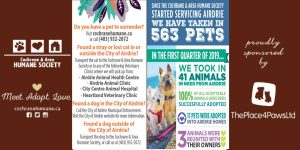
Since Cochrane and Area Humane Society started servicing Airdrie, in 2016, we have taken in 563 pets from the city. So far this year we have taken in 41 homeless animals and 17 pets were adopted into Airdrie homes.
Having a presence in The City of Airdrie is important to CAHS. Our focus for 2019 is to continue to help all Airdrie families and pets in need through our various rescue, re-homing, surrender, lost and found an emergency programs. This also involves providing educational opportunities for children, youth and adults.
Be sure watch for us on June 1 and 2 at the Airdrie Children’s Festival where we will have a display of animals and education. Kids are welcome to ask our volunteers and staff from the CAHs to demonstrate examples of how to teach dogs manners and obedience.
We would also like to extend an invitation for you to join Tracy Keith, CAHS’s co-founder and executive director, at the shelter on Sunday June 9 from 1 to 5 p.m. for Off Leash Dog Park Seminar where you will have an opportunity to learn etiquette, rules and most importantly safety skills for you and your dog while visiting off leash parks. Registration information can be found on our website.
CAHS’ Positive Approach Canine Education is now taking enrollment for our fall program. If you are interested in becoming a well-rounded and certified dog trainer, we have much to offer, from the animals to the experienced instructors.
On April 27 and 28 at the Airdrie Home and Lifestyle show, we spent time teaching about the importance of animal enrichment, which can involve everything from daily dog walking to play-time with other animals, a good old game of hide and seek.
Other examples of enrichment items are Kongs filled with peanut butter or pumpkin, frozen treats, snuffle mats or toilet paper rolls and cereal boxes full of goodies where dogs have to work to get into using their instinctual tactile skills. Next time you visit your local Cochrane or Aridrie Pet Valu store be sure to ask them about making am enrichment item donation for CAHS and how they will match your donation.
If you are interested in becoming a volunteer within the shelter or for events in your city please contact us today at volunteer@cochranhumane.ca.
Week 12: More Than a Shelter

It is often through adversity that the strongest teams are built. Over twenty years ago it was the adversity of having her own dog go missing that Tracy Keith, Cochrane & Area Humane Society’s (CAHS’) co-founder and executive director, began to plant the seeds of what has grown into much more than a shelter. It has become a strong community player; changing and saving lives through rehabilitation, education and most of all hope as it continues to lead the way for kindness to animals and responsible pet ownership in all rural communities.
Taking what the CAHS team has learned over the past two decades of working with animals and offering education at every level, from our Positive Approach Canine Education (PACE) to community seminars like Speak Dog Seminar, are what continues to build CAHS’ entire winning team.
Last month CAHS’ Tracy Keith, CBCC-KA, CPDT-KSA and Vanessa Fischbuch, CPDT-KA, CAHS, held a Speak Dog Seminar, sponsored by Global Pet Foods Cochrane, where they shared valuable information with about 70 people through photographs, video and live demonstrations about understanding a dog’s body language, how animals learn and how their people can learn from them, for an all-around win-win-win.
Because behavioural problems are the most common reason why people surrender their dogs, addressing behavioural issues is a key component for success. These issues can range from biting or aggression to barking and destruction.
Reading the subtle – and once you know, not so subtle – messages before behaviour becomes a problem, is the key to longevity, health and happiness for every dog.
It is often through body language that the most telling sings of how an animal is feeling, from stressed and uncomfortable to happy and relaxed. Yet, all too often these signals are misread or go unnoticed by the people around them. Speak Dog Seminar offered something for everyone.
Building CAHS’ own winning team begins at the core and reaches out to our entire community through education. This is where hope flourishes and continues to be the challenger to all adversities. The question and the key to overcoming the animal’s adversity begins with asking why. And, like all answers, it is discovered through understanding and education. Keith and Fischbuch offered both.
The next public seminar put on by Tracy Keith is Off Leash Seminar on June 9. For more information on upcoming seminars please visit our website. (www.cochranehumane.ca/events/upcoming-events/)
If you know your dog is trying to speak to you and you would like to understand please contact us at behaviour@cochranehumane.ca where our professionally trained staff can help you hear.
Thank you to The Place 4 Paws for helping us reach our Airdrie community by sponsoring our weekly blog.
Week 11: Cheyenne’s Silver Lining

A beautiful bundle of fuzzy sweetness, Cheyenne, was brought into the Cochrane & Area Humane Society (CAHS) on Jan. 27 through Canine Action Project which is one of our partners with our Rural Rescue Program, sponsored by Pet Valu Cochrane.
After an emergency visit and care in our vet hospital, a request was put out to our foster homes looking for loving hands to care for this girl and help bring her back to health. Along with her photograph, our foster coordinator sent out what we knew: one-year-old injured female mixed breed dog.
Almost 8,000 km away, Ivanie Blondin, Canadian Olympic speed skater, received the photograph and the request while she was on her way to compete at the 2019 ISU World Single Distance Championships in Inzell, Germany and was immediately drawn to Cheyenne.
The once crowned world champion in 2016 won a silver medal at that competition, and after landing at the Calgary International Airport a couple of days later, Cheyenne received her own silver lining of hope when Blondin and her partner, Konrád Nagy, came straight to the shelter and took her home.
“She had that Mountain Dog face, and my heart just kind of sunk a little bit,” relays Blondin, who has a St. Bernard-Pyrenean mountain dog cross, Brooke, as well as an African grey parrot named Gizmo.
I always find my way to animals, and they find their way to me. – Ivanie Blondin
Blondin says that it is in her nature to help animals and that has been a passion of hers for her entire life. She has taken previous training in animal care and is something she may pursue in the future. Right now, though, while training and competing takes up the majority of their time, CAHS is fortunate that Blondinand Nagy choose to donate their free time to animals in need.
When the couple first brought Cheyenne home she was waking up every third hour, but it didn’t take long before Cheyenne realized she was in good hands and began to relax and heal.
“We saw her grow so much; she was very energetic and social and Brooke and she would play her all day long.”
Hours were spent by caring for, bathing, grooming and taking Cheyenne out for walks until she was ready to find her forever home. Which she did.
When friends of the family came over to meet the new temporary member, they ended up falling in love with her and eventually adopting her. Madelaine and Myles, who adopted this lovely girl have renamed her Lily. They say she is doing awesome in her new life and loves playing with other dogs. The families even continue to get together for walks and plays.
“It is nice to see her continue to grow and have a family now,” says Blondin.
Blondin says that being a competitive athlete has provided her with many opportunities to grow as a person – in and out of the rink. While celebrating the wins and overcoming the losses is a mental and physical game, she says that surrounding herself with furry and feathery companions has been a great help for overall success.
If you are interested in becoming a foster home for one of our animals please contact foster@cochranehuman.ca for more information.
Thank you to The Place 4 Paws for sponsoring our weekly Petlife post in airdrielife.com.
Week 10: WIN WIN WIN More than a Shelter

Bringing home a new puppy is guaranteed to bring limitless laughter and continuous cuteness. It is also sure to involve forever fine-tuning and additional adjustments in the homes of the new families. At the Cochrane & Area Humane Society (CAHS), the ultimate goal of saving lives begins and ends with education for success. The outcome is a win-win-win: for the animals, their potential homes and the staff and volunteers within the shelter.
Because we know puppies will be puppies, in March CAHS held a Volunteer-Puppy Bootcamp, put on by Vanessa Fischbuch, Certified Professional Dog Trainer at the CAHS.
The four sessions were designed to help set the puppies up for adoption success through the development of obedience: attention, sit, down, come, loose leash walking and recall and life skills: socialization, handling, food bowl etiquette, play, behavior, boundaries, relationships and manners.
Susan Spooner, one of the volunteers in the camp, was impressed with the “wealth of knowledge” offered by Fischbuch.
“The puppies benefit from the consistent individual training and volunteers have a wonderful opportunity to learn training techniques from an expert, as well as getting lots of puppy love,” said Spooner.
Cultivating this culture where knowledge holds the power for long-term happy-forever-afters is a key component of what makes CAHS more than a shelter.
During the intensive two-week training, volunteers and their matched puppy learned valuable foundations of obedience and socialization skills through positive reinforcement and consistency. The volunteers were able to foster or spend extra time with their assigned pups outside of the training. This practice created an opportunity for the volunteers to experience first-hand how profoundly they can make a difference in the lives of an animal, and how quickly a puppy can learn.
The reward was the results. The advances that were made within a very short time were substantial. Drifter, who was shy, came out of his shell; Cheerio who was older, was able to enjoy some much needed one on one time; and the four Sporty Puppies developed manners that will help them flourish in their new homes. At the same time, our volunteers gained valuable skills to assist even more animals in the future, in the shelter and in their own lives.
If you are interested in volunteering with the dogs at the shelter, please visit our website at www.cochranehumane.ca/volunteer/apply-now/ and start making a difference today. Whatever your animal skill-set is, CAHS will provide many opportunities to help you help us help the animals win-win-win.
If you have added a new furry friend to your home, CAHS offers a wide variety classes and seminars. To find the right one for you please contact us at 403-932-2072 or view our classes at www.cochranehumane.ca.
Thank you to The Place 4 Paws for sponsoring our weekly Petlife post.
Week 9: In and Out of the Shelter
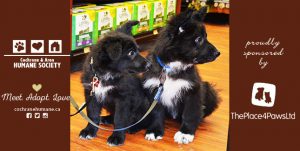
Because reaching out and having a presence in the community is important to us, Cochrane and Area Humane Society (CAHS) is working on building a team of staff and volunteers for events. As much as we want to encourage people to visit the shelter, we also want to visit you.
We hope you will watch for us at the Airdrie Home and Lifestyle Show on April 27 and 28. We will also be bringing animals, with a focus on education, to the Airdrie Children’s Festival on June 1 and 2.
In the month of February, staff, volunteers and animals from Cochrane & Area Humane Society (CAHS) visited four pet stores for their National Adoption Weekends.
Because it was puppy-land at the shelter, our focus was on getting puppies adopted when we spent the weekend at Pet Smart in Beacon Hill, Calgary from Feb. 22 to 24. We are happy to say that over the weekend six puppies went to their forever homes from this visit. Thank you to PetSmart who granted us $250 to cover some of the surgical expenses for spaying and neutering these animals.
Three Pet Valu stores, Pet Valu Cochrane, and Pet Valu Main Street and Pet Valu Coopers Crossing in Airdrie, were also visited on Feb. 16 and 17 by Larch and Linden, who showed off their fabulous manners. Both have now been adopted to happy homes along with the rest of the seven Lovely Puppies.
It was wonderful to see our animals who visit the stores get adopted through these events, and it was just as wonderful to see the interest in our older animals through our displays of printed photographs and via our website and the interest in the many programs offered for new adoptees and their families.
Thank you to our volunteers who smile the entire time as they proudly share information about our shelter programs and animals in and out of the shelter.
If you are interested in helping out or getting involved, visit www.cochranehumane.ca to find the perfect place for you.
Thank you to The Place 4 Paws in the Airdrie area for sponsoring our weekly blogposts!
Week 8: When Nothing is Wasted, Much is Gained
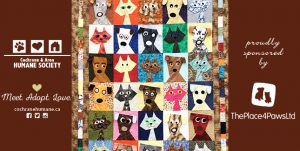
Some of the most common questions we get asked about our animals are, “Where did they come from, how big will they be and what will they look like?”
This sounds a lot like the questions Cochrane & Area Humane Society’s Quilting for Critters group has to decide when they are beginning a new project. How big will it be? What will it look like? Where will the fabric come from?
Each quilt comes from “scraps” or extra fabric that is donated and sewn together piece by piece to create a final masterpiece of uniqueness that could never be completely duplicated. Each person adds her own flare of colour and talent to her patch that will be joined together with the others. Somewhat similar, yet still distinct.
Parallel to adding a new furry friend to your family; you think you know what you are going to get, yet the final outcome is so special and unique, it could never have been imagined.
For the past three years, this group of about 13 ladies gather together regularly through their two common loves: animals and sewing. They have been able to raise about $7000 so far for our animals through their quilts, which have been raffled off and auctioned at our annual gala, as well as other projects like the Mutt Mats that can be found in Norm’s Nook.
Once all the individual squares are made, they are pieced together to form the quilt-top, and then the final step is making it into a quilt, which is done by a long-arm quilting machine. Andrew and Tracy Bentley, owners of Maple Leaf Quilting Company Ltd., Cochrane’s local long-arm quilting store and Western Canada’s distributer of Gammill long-arm quilting machines, along with their staff, generously donate their time and machines to complete the quilts. Much gratitude to Maple Leaf for this and for the many other “scraps” that are not wasted, but turned into cat beds, mats and blankets for our animals.
Thank you to our entire community of unique individuals, who care about animals as much as we do, for using your gifts and talents to help make CAHS and our mission of saving lives a success.
Week 7: Little Piece of Heaven
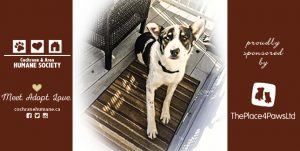
There is a legend that dogs with two colors of eyes have one eye on earth and one eye in heaven.
That was the introduction to Zack’s profile on the Cochrane and Area Humane Society (CAHS) website when he was finally ready to be put up for adoption after a one-year stay with CAHS. Zack is now heading into year-three of his new life.
Zack came into the shelter, when he was about 4, in February of 2017 with an injury that required emergency surgery and a long road of rehabilitation. One year later, his new family, who saw something special in this beautiful boy, took him home.
The journey of healing was a difficult one for Zack, but he was fortunate to be cared for in the loving foster home of Alana, while in the care of CAHS, who to this day his new parents Kevin and Shelley have much gratitude for – and still keep in contact with.
“We have had Zack almost one year and he has fit into our family like he has always been with us,” says Shelley.
Now that Kevin and Shelley understand Zack they are able to prepare for situations that make him uncomfortable and make environmental adjustments when needed. He does not like assertive behaviour from other dogs and still doesn’t like going to the vet, but that the little piece of heaven that can be see through his eyes has come out many times when Zack displays his warm and gentle nature especially around little girls.
Shelley shares a story.
“Kevin was just completing his walk and almost back to the car when Zack saw a lady with a small 5-year-old girl. Zack immediately left Kevin to say hello. Zack knew the little girl was a bit shy so he sat beside her until she began to stroke Zack. Kevin caught up to mom and child to reassure all that Zack loves little girls when he noticed that the child was a special needs and that Zack had it all under control. He could have stayed with her all afternoon. Other dogs were dashing about and playing but Zack knew that his place was a gentle visit with a special little girl. Both Kevin and her mom were crying.”
Foster mom, Shelley, says that the “rule of the first threes” that was taught to them by CAHS’s Dawnita Gillman, CPDT – KSA, who spent time with the family in private classes, was something they have thought about many times during the past year. Gillman says that this rule is a reminder to the adoptees that it takes time for new animal members to get used to their new homes and to build trust.
“Having compassion and seeing it from the dog’s perspective,” says Gillman.
These rules are taught by Dr. Patricia McConnell and Dr. Karen B. London.
Thank you Shelley and Kevin for seeing that little piece of heaven in Zack and giving him a second chance to show his true self. We wish you all the best in this third-year of Zack’s new and wonderful life.
CAHS offers various group classes and private consultations for families who have added a new animal member. For more information please contact us at 403-932-2072 or visit our website. (www.cochranehumane.ca/programs/dog-training-and-behaviour/)
Week 6: Forever Gratitude goes Hand-in-Paw
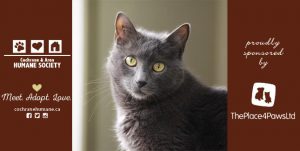
Some of the greatest of life’s moments and the lessons that go along, hand-in-paw, are gifted through the unspoken tales that are told through the eyes of the animals who have walked thousands of miles. This is something that Cochrane and Area Humane Society (CAHS) has always regarded, which formed the foundation for the future of forever animal care.
For CAHS it all started with a cat named Norm, who called the shelter home for 15 years. He was a companion to many who shared their offices and lunchroom or as he walked by their side up and down the halls of CAHS. In the end, it was clear that Norm gave to his beloved people much more than he ever took. Over the years there have been many others like Norm who came into the care of CAHS and never left.
Valuing each life has always been the unspoken promise held in the hearts of CAHS staff and volunteers. Now this promise of endless compassion has an official title: Palliative Paws Program, which was made possible by Global Pet Foods Cochrane.
Kari Broadhurst has found a special place in her heart and home for animals in the Palliative Paws Program.
After having the experience of sharing the precious last stage of life and the death of animals in her care she says, to her, it is a privilege.
Today, Broadhurst is caring for a cat named Noah.
“He deserves that love, and to know he is not just another foster, he is one of mine.”
The cost of palliative care can be substantial for a shelter, but through the generosity of supporters like Global Pet Foods Cochrane, CAHS can continue to provide its foster families all of the necessities such as specialized food, bedding, crates, medication and all veterinary care.
Foster parent, Sharon Pye, says that for her offering comfort to an animal who is afraid or longing to be held, is the “obvious” thing to do. She wants the animals to know that they were loved and that they made as much of a difference in her life as she did in theirs.
“If it’s possible, I try to be the one who is holding them when they take their last breath,” says Pye.
Fostering animals who require special attention and those you know you don’t have an entire lifetime with it is not easy, but for Pye there is no greater reward. She says that if someone wants to know they are making a real difference, the Palliative Paws Program is the one.
“A little one is waiting for you and your love.”
Thank you to all of the loving hands who continue to hold the tender paws until the end. Because of you, the unprecedented future of forever animal compassion is being set and the world is sure to be a better place.
Week 5: Home Alone
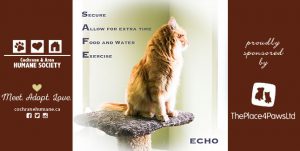
Leaving your new pet at home for the first time may require some adjustments to your routine.
Here are some tips to help you with leaving your new pet home alone and SAFE until your return.
1. Secured area: Providing a safe, nurturing and comfortable environment is essential for your pet. Some things to think about are cleanliness, temperature, calmness and natural light. Remember your pet is still adjusting to their new surroundings; introducing him to new areas and people is good to be done with your support and presence. It is best not to let your new furry friend have complete run of the house when you are gone. He is safest in a secured, comfortable place with appropriate toys to chew on and play with. Pens and baby gates are handy ways to keep dogs and puppies secure, yet not completely closed off. Be aware of items such as wires, drapes, electrical cords, shoes and furniture that may get ruined and can also harm your new friend. And don’t forget to close your toilet lid!
2. Allow for extra time: You may want to set your alarm earlier to allow for extra time in the mornings. This way you do not feel the anxiety of being rushed, and neither will your pet. It is also important to go straight home after work so you don’t get caught up in the quick-errand-time-warp. The amount of time you leave him will depend on his age. New puppies may only be able to handle being alone for two hours at a time at first, but don’t worry, it gets longer with age!
3. Food and Water: Adhering to a feeding schedule is important for your pet. Be sure he is fed before you leave and that there is fresh water available. Lack of appetite can be a sign of mild stress; be sure to monitor food and water intake to prevent low blood sugar or dehydration. Other signs include: diarrhea, submissive behavior or trying to hide. Be patient with your pet, building trust can take time. If there are indications of illness, such as diarrhea, vomiting, lethargy or not eating for more than a day (for puppies under 12 weeks) it may be cause for concern. For kittens, watch for these as well as open-mouth breathing or wheezing. If ever in doubt, please call your vet.
4. Exercise: Making time for play or adding a morning walk to your routine will help your new dog burn off energy. After some exercise your pet will probably be ready for a nap just when you are ready to leave. Pets respond well to regular routines just like everybody else.
5. Socialization is also important – for you and your new friend. If you are would like to enroll in puppy play-dates or obedience obedience classes, please check our our website to see our upcoming activities and classes. If you are interested in learning how to better communicate with your dog or dogs in general, Cochrane and Area Humane Society is holding a Speak Dog Seminar on March 15 from 6:30 to 9 p.m. with a focus on understanding body language.
If you have done all of the above, lastly let go of any guilt. Instead, think about the excitement of walking through the door at the end of the work or school day!
A big thank you to The Place 4 Paws for sponsoring this blog.
Week 4: Not Giving Up
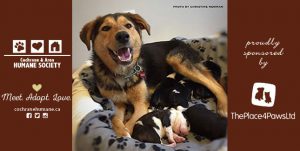
The number one question Cochrane and Area Humane Society’s (CAHS) foster parents, Rachelle Elburg and Christine Newman, get asked is, “Isn’t it hard to give them up?”
Their response is that they are not “giving up,” but rather they are giving the animals they foster an amazing start with much love.
“So that they can go on and fill someone else’s heart with love,” says Elburg.
Kodak and her five pups came to the shelter on Dec. 1, 2018 with over 30 other dogs from Canine Action Project (CAP) based out of Saskatchewan, which is supported by CAHS through our Rural Rescue and Support Program.
Elburg was in charge of completing the intake information for the animals when they arrived at the shelter and was immediately drawn to Kodak.
“I could tell she was gentle and her eyes were full of kindness – sometimes you just get a feeling about a dog,” explains Elburg.
Having fostered three times before, Elburg knew that it could be a lot of work. But, after consulting with Newman, receiving approval from CAHS’ foster coordinator and having the animals examined by our hospital staff, the entire family went to their loving temporary home two days after their arrival.
Because Newman is a photographer, the couple named the mom Kodak, the two boys Canon and Pentax, and the three girls Fuji, Nikon and Polaroid.
Mama Kodak was a little unsure at the start. She wouldn’t walk on their wood floors and had to be carried outside. She wouldn’t go downstairs and didn’t really seem to know what a toy was. All changed very quickly because fortunately Kodak was with Elburg and Newman over a warm holiday season where she enjoyed many gifts of toys and long walks each night to look at the Christmas lights.
Elburg says that at 10-days-old, with eyes still closed and unable to walk, Kodak did most of the work of feeding and cleaning her pups. When their eyes started to open, it was a surprise to see that three of them had blue eyes. By three weeks Elburg says the “real fun” began.
“It’s so amazing to see their little personalities start to come out.”
For Elburg and Newman, fostering animals has been extremely rewarding. Watching them grow, laughing while they learn to walk and endless amount of cuddling all bring the reward of unconditional love.
Saying goodbye always comes with the hope that the animals find a family who loves them as much as they do. The ultimate reward is seeing the animals in their new homes and knowing that they in fact did not “give up”, but were able to give more – bundles and bundles of love.
All of the five puppies and Kodak have now been adopted. They are all doing great in their new homes and very much loved by their new families.
The CAHS was founded with the knowledge that rural communities often require unique supports and animal welfare services to ensure the health of animals and people in the communities. Our Rural Rescue and Support Program partners with communities and other organizations like CAP to help provide those needs.
In 2018, CAHS assisted 1893 animals with 454 of them coming through our Rural Rescue and Support Program from six rescue partners. Funds donated to this program go towards transportation and hotel costs, food and shelter for the animals, veterinary care, behavioural rehabilitation and placement into their forever homes. If you or someone you know would like to donate to help support our Rural Rescue and Support Program, please contact (403) 932-2072.
Thank you Cochrane Pet Valu for sponsoring our Rural Rescue and Support Program and to Four Feet Foundation for providing a grant to help transport animals from our rescue partners.
Week 3: Foster Requirement: A Big Heart
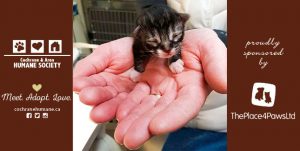
For animal lovers who may not be able, or ready, to own a pet of their own, opening one’s heart and home to fostering an animal might be a great alternative.
Sheila French, who has been fostering animals for the Cochrane and Area Humane Society (CAHS) for about 19 years, says the main requirement is “a big heart.”
“It will be broken, but the joys of watching frolicking puppies and listening to happy purring far outweighs the sad times,” relays French.
She remembers her first foster dog, Sunny, a young dog with mange.
“Being my first foster animal he was the hardest one to say goodbye to,” recalls French.
Letting go has gotten easier over the years; although, it is still sometimes difficult for French when it is time to say goodbye to the adult animals.
“They often aren’t adopted as quickly as the litters of kittens and puppies.”
French has fostered cats and dogs, ranging from pregnant moms who have given birth to their babies and seeing them through to their weaning and surgery, to animals being treated and recovering from a broad range of health issues.
“Sometimes the outcome hasn’t been favourable, but I know I’ve given them a chance.”
French says that fostering has been her way of giving the shelter animals some in-home TLC, which some have never been given. One of the challenges has been that there is often no history on an animal. She suggests to be as equipped as you can to prevent playful destruction from puppies and to be prepared for behaviour issues that may arise and need to be worked through.
The benefits of becoming a foster for CAHS are that all the veterinary care is provided and if there are behaviour issues, there is well trained staff to consult and opportunities for training if foster homes want to improve their own personal skill sets. All of the supplies that foster homes need for the pets are supplied by CAHS, including food. Every animal that comes into CAHS is spayed or neutered at the shelter.
Although French has named herself a “foster failure” on several occasions, which means the lucky animal ended up becoming a part of her forever-family, she says she soon came to realize she can’t keep them all and that eventually most animals find their own perfect home.
“Seeing animals you have fostered in their forever homes is so gratifying.”
Our foster families are very much appreciated by everyone at CAHS. It opens space for more animals to come in and it offers an insight into an animals’ likes and dislikes, which helps in finding the best suited forever-family. If you or someone you know is interested in becoming a foster please contact foster@cochranehumane.ca
Week 2: The Essence of Pepper
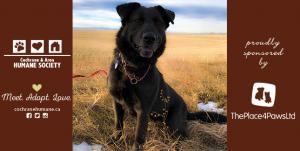
Pepper’s perfect companion is salt. Salt is a mineral and is a vital source of life; it is sometimes referred to as the essence of life itself, and black pepper is the warmth, known for versatility and compatibility. They are always placed together on the table side-by-side, to be used in a complimentary way to add flavour to every dish. They have become known as the soulmates of cuisine which is what our girl Pepper has been searching for in her perfect companion – a soulmate.
Pepper was brought into the Cochrane & Area Humane Society (CAHS) after having lived on her own her whole life and fending for herself in a rural environment. She was fearful of humans due to a lack of interaction and her survival skills were used to their fullest each and every day as she persevered to beat the elements and the odds.
The CAHS has spent almost two years integrating Pepper into the “human world” and what a journey it has been! She has changed many of our lives as much as we have impacted hers.
The folks working with Pepper persevered just as Pepper has, and at times it felt impossible. Dedication, love, patience and commitment to Pepper’s well-being have paid off and now she is ready for the next stage of her life.
The next leg of Pepper’s journey includes finding her forever home. She is looking for a soulmate kind of person that will continue her journey to becoming a dog that loves and trusts people. Her ideal person would have a quiet, adult only home that would have another dog that she enjoys, takes comfort in and will learn good behaviours from.
What would it take to be Pepper’s salt? Patience, dedication and lots of love.
Our knowledgeable behaviour team will work with a potential new home to get Pepper feeling comfortable with them in her existing environment before she goes to their new home. We will provide continued support and expertise to Pepper and her people in the months following to help set everyone up for success.
The intrinsic quality of dogs is loyalty, and like salt and pepper, loyalty and love go hand-in-hand; each one’s qualities making the other complete.
When love leads with patience and perseverance, loyalty follows.
This month, the month of love, if you are seeking your perfect soulmate – or perhaps a best friend who is one of many mates of your soul, let it begin with knowing and becoming your own essence. From there, finding a perfect and complementary companion is sure to transpire.
If you would like to learn more about Pepper, please contact our adoption department at 403-932-2072 or adoption@cochranehumane.ca.
Week 1: February 10th, 2019
Pets and Vets: Good for the Heart
Cardiovascular disease is a leading cause of death world-wide and February, being National Heart Month, the Cochrane & Area Humane Society (CAHS) wants you to know that we are doing our part to help your heart-health.
The Pet Effect Campaign, which promotes the health benefits of caring for animals states, “Professionals who help keep pets healthy are also key contributors to human health and public health.”
At CAHS, our mission is to lead and educate our communities in animal welfare by providing pets in need with shelter, rehabilitation, training and opportunity, and supporting people in responsible pet care. This includes saving and changing lives.
Owning a pet can add years to one’s life through physical activity, but there is more to it than just exercise.
Studies also show that the pet-human bond can help get people out of the loneliness state of mind, which is a major factor in depression and other forms of illness. The companionship and nurturing that loving a pet offers reduces stress levels and lowers heart rates. Feelings of isolation are lessened with a constant loyal friend, partly because of animals’ need for security and attachment and through the social interaction with other humans because of their commonality.
CAHS holds many events and activities for animal owners and volunteers who want to enjoy the benefits of the human-animal bond. We believe that animal advocating is an entire community issue. The good news is that as our entire team, from our veterinary staff to our sponsors, are working to save the lives of animals, those animals in turn are saving the lives of their beloved people.
From our hearts to yours, during National Heart Month, CAHS invites you to be heart-smart – get involved or adopt a pet to add years to your life.

